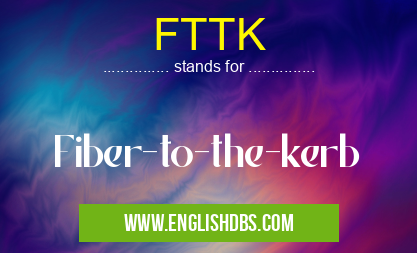What does FTTK mean in INTERNET
FTTK stands for Fiber-to-the-Kerb. It is a broadband technology that delivers fiber-optic cables to the kerbside or roadside cabinet near the customer's premises. From there, the connection is extended to the home or business using traditional copper or coaxial cables.

FTTK meaning in Internet in Internet
FTTK mostly used in an acronym Internet in Category Internet that means Fiber-to-the-kerb
Shorthand: FTTK,
Full Form: Fiber-to-the-kerb
For more information of "Fiber-to-the-kerb", see the section below.
How FTTK Works
FTTK utilizes fiber-optic cables to transmit data over long distances with high speed and low latency. The fiber cables are laid underground or overhead to the kerbside cabinet, which serves as a central connection point.
Once the fiber reaches the cabinet, it is converted into electrical signals and transmitted to the customer's premises via copper or coaxial cables. This final leg of the connection may result in a slight drop in speed compared to pure fiber connections, but it still offers significantly faster speeds than traditional DSL or cable broadband.
Advantages of FTTK
- Higher Speeds: FTTK provides much faster download and upload speeds compared to traditional broadband technologies.
- Low Latency: Fiber-optic cables have extremely low latency, making FTTK ideal for real-time applications such as gaming and video conferencing.
- Reliability: Fiber-optic cables are less susceptible to interference and outages, resulting in a more reliable internet connection.
- Future-Proofing: FTTK can support the ever-growing demand for bandwidth, making it a future-proof solution for households and businesses.
Disadvantages of FTTK
- Limited Availability: FTTK is not yet widely available in all areas.
- Potential Speed Drop: The copper or coaxial cables used for the final leg of the connection may introduce a slight drop in speed compared to pure fiber connections.
- Cost: Installing FTTK infrastructure can be more expensive than traditional broadband technologies.
Essential Questions and Answers on Fiber-to-the-kerb in "INTERNET»INTERNET"
What is Fiber-to-the-Kerb (FTTK)?
Fiber-to-the-Kerb (FTTK) is a broadband network architecture where fiber optic cables are extended from the central office or exchange directly to a distribution point located near or at the curb of a street, typically within 300-500 meters of homes and businesses. The remaining distance to the premises is then covered by existing copper infrastructure, such as telephone lines.
What are the benefits of FTTC compared to other broadband technologies?
FTTC offers several advantages over traditional copper-based broadband:
- Higher speeds: Fiber optic cables can transmit data at significantly higher speeds than copper, providing faster internet connectivity and improved streaming capabilities.
- Lower latency: Fiber optic cables have a lower latency than copper, resulting in faster response times for online applications and gaming.
- Increased bandwidth: Fiber optic cables have a wider bandwidth than copper, allowing for multiple high-bandwidth applications to be used simultaneously without experiencing slowdowns.
- More reliable: Fiber optic cables are less susceptible to electromagnetic interference and physical damage than copper cables, resulting in a more stable and reliable connection.
What are the different types of FTTC architectures?
There are two main types of FTTC architectures:
- FTTC-VDSL: This architecture uses VDSL (Very-high-bit-rate Digital Subscriber Line) technology to deliver high-speed broadband over the copper connection from the curb to the premises.
- FTTC-G.fast: This architecture uses G.fast technology to deliver even higher-speed broadband over the copper connection.
How is FTTC installed and deployed?
FTTC installation involves:
- Fiber optic cable installation: Fiber optic cables are laid from the central office or exchange to the distribution point at the curb.
- Copper connection installation: Copper lines are run from the distribution point to the premises.
- Equipment installation: Fiber optic modems or routers are installed at the premises to convert the fiber optic signal to an electrical signal that can be used by devices.
What are the limitations of FTTC?
FTTC has some limitations:
- Distance: The copper connection from the curb to the premises can introduce signal loss and reduce speeds, especially over longer distances.
- Copper infrastructure: The quality and condition of the existing copper infrastructure can impact the performance of FTTC.
- Cost: FTTC can be more expensive to deploy than traditional copper-based broadband due to the cost of fiber optic cables and installation.
Final Words: FTTK is a broadband technology that offers a balance between the speed and reliability of fiber-optic cables and the cost-effectiveness of traditional copper or coaxial connections. It provides faster speeds, lower latency, and higher reliability than traditional broadband technologies, while still being relatively affordable. As FTTK infrastructure continues to expand, it is becoming an attractive option for households and businesses seeking a high-performance internet connection.
